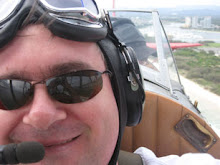"The 3-D gaming platform was developed at the University of Southern California's School of Cinema-Television, and for now is aimed at re-creating popular schoolyard games such as red light, green light; dodge ball; and capture the flag.
In Red Light, Green Light, one player assumes the role of the traffic cop, and calls out stop and go commands that are interpreted using voice-recognition software. Virtual pedestrians close in from all sides. In a twist worthy of Bladerunner, the object is to determine which of the walkers is the single human opponent, and blast the target into oblivion. A side arm of sufficient caliber to engulf suspects in a satisfying spray of pyrotechnics is provided.
Thanks to the novel 3-D feature, the cop player must stand and physically spin around to view the field."
Next up,
by Ross O'Shea is a student project where your real world activities effect your game character. This hip pouch and badge is full of electronics and as you wear it throughout the day, it senses and records data; how many steps you have taken, how much you speak, size, temperature and brightness of your environment.
This device has currently been prototyped using the RPG Morrowind. In usual circumstances, a player might make an avatar that is a fitter, stronger more attractive version of themselves. The G-Link reverses this and says if you sit in and play games all day, your character will be weaker, yet if you go out for a walk then your character will be stronger. Also if you go out in the sun your character will be light aligned, yet stay indoors and it will go over to the dark side. Recently part of the CoEDD graduate exhibition."
And then,
is a Java game for the mobile platform, designed for people who are so bored they'd rather be dead. Mobile games, are after all, a catharsis for transient boredom. This parody, platform shooter sees players influence game dynamics by first inputting self-worth parameters. Players with the highest level of self-hatred enjoy the longest games of self-sacrificing mutilation. Those who love themselves most find the game ending almost before it begins."

"After choosing a character who 'looks like you feel', and inputting the 'degree to which you hate yourself', game play consists of repeatedly killing copies of the character you choose, whilst listlessly meandering through 'Happy Town'. The game is designed to increase in difficulty exponentially to player self-hatred, resulting in the most self-hating players experiencing the most difficult time completing the game. Thus, ironically, self-hatred is rewarded with greater cause for self-hatred, simultaneous to an increased opportunity to indulge this self-hatred by continually shooting replicas of oneself to pieces. The game is won when the game itself decides that the player has persecuted themselves sufficiently, relative to their natural tendencies towards self-persecution."
Part of the Mobile Journeys exhibition at the Sydney Opera House.
And finally, an article from DV.com (requires registration) about a couple of guys from the Bronx who have been running their own IPTV network for the last three years.
"In 1992, (Doug) Frazier and (Stuart) Reid got their big break when the city of New York decided to create a citywide, broadband franchise for voice, video, and data services. They became one of five founding franchisees--alongside the likes of AT&T, Cablevision, and Time-Warner--suddenly finding themselves in direct competition with billion-dollar corporations. For any two individuals, let alone two working-class African-Americans, this was a remarkable turn of events. It's easy to indulge Frazier in a little hyperbole (if it even amounts to that) when he says, "That was the largest franchise that had ever been given to somebody that looked like us, ever, in the history of this country..."
Perhaps the biggest advantage of all is UTV's deep understanding of their customer base, which is more intimate than any market research budget could possibly buy.
The difference can be seen in UTV's programming. Sure, of their 300-plus total channels, the vast majority are the same as you'll find on most cable systems. But a few of them definitely are not. Recognizing that some of their customers, as Frazier delicately puts it, "are not sophisticated about the Internet," UTV licenses a number of media streams off the Internet, converts them to MPEG-2, and routes them onto their TV platform as TV channels so their customers can find them easily.
In particular, with the demographics of the south Bronx in mind, they look for television and radio channels from the Caribbean and Latin America that aren't otherwise available. Some of these channels look pretty bad, of course, and Reid relates a telling anecdote about a big argument they had with their engineer over the quality of the feeds. At one point, they decided to remove a channel from Puerto Rico. "The phones rang off the hook. 'Why'd you take it off?!' . . . 'The technical quality's not good enough' . . . 'We don't care! That's TV from home!'"


No comments:
Post a Comment